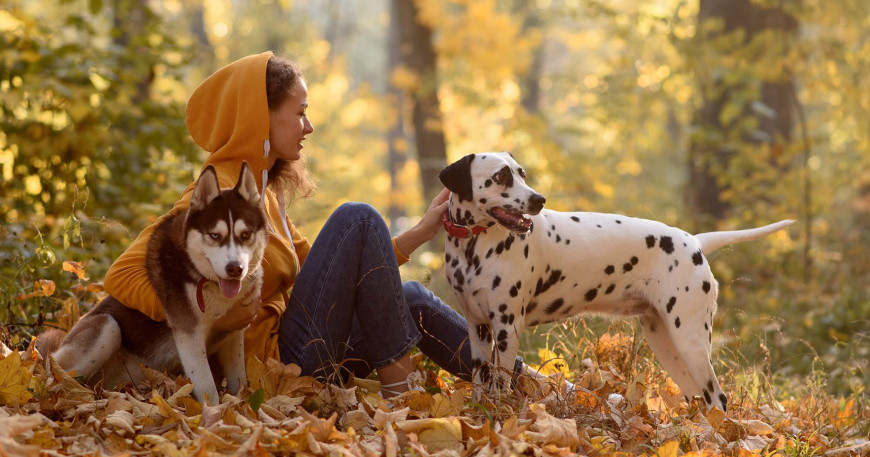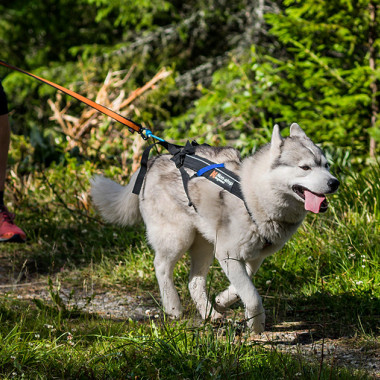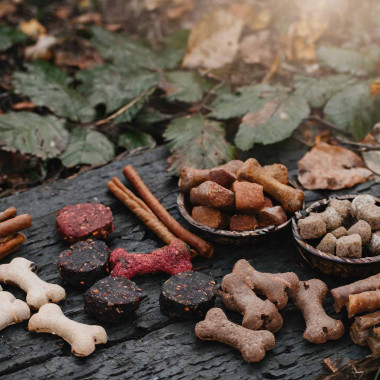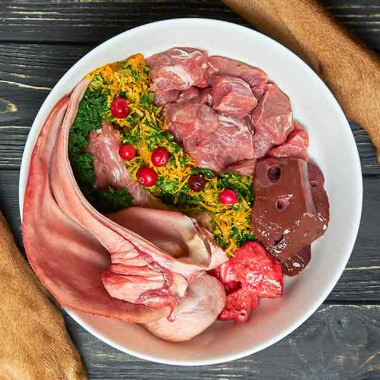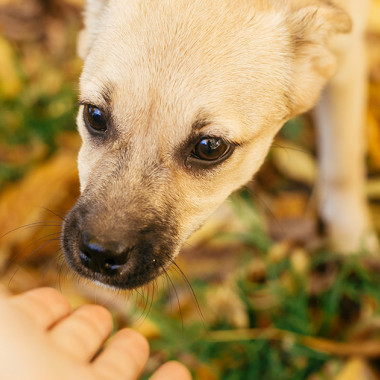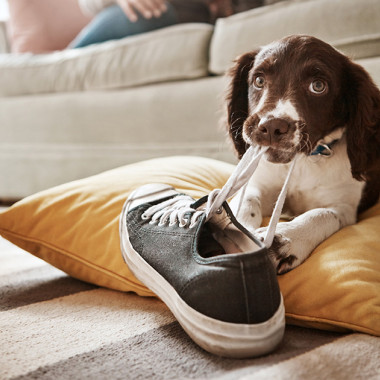When a four-legged friend arrives in our homes, our lives change. Not only do we consider dogs as family members, but we often see them as a source of endless joy, loyalty, and love. In this comprehensive guide, we cover everything you need to know about caring for your canine companion, with a particular focus on BARF feeding - a modern approach to nutrition that can significantly contribute to your dog's health and well-being.
Domestic Dog - History, Domestication, and Theories on Origin
From the dawn of civilization to the modern era, domestic dogs (Canis lupus familiaris) have been and continue to be an integral part of human society. In the introduction of this article, we explore the fascinating journey of dogs from wild ancestors to man's best friend. We will examine various theories on the origin and domestication of dogs. We will look at how dogs became an indispensable part of our lives and clarify the scientific knowledge that helps us better understand this unique relationship.
Prehistoric Beginnings
The beginnings of the shared journey of humans and dogs date back more than 15,000 years, to the period at the end of the last Ice Age. The oldest evidence of dog domestication has been found at several archaeological sites in Europe and Asia, suggesting that the domestication process may have occurred independently in various parts of the world. These early forms of domesticated dogs were likely very similar to today's wolves, supporting the theory that dogs are direct descendants of wolves (Canis lupus).
Domestication and Evolution
The domestication process probably did not begin with a deliberate human decision but rather through natural selection. Wolves that were less fearful and aggressive towards humans may have gained food and protection by staying near human settlements. These individuals gradually exhibited greater social tolerance towards humans, leading to mutually beneficial cooperation. Over time, these animals genetically and behaviorally diverged from their wild ancestors, leading to the emergence of the first generation of true domestic dogs.
Various Theories of Origin
There are several theories about how and where exactly dog domestication took place. The traditional theory suggests that dogs were domesticated only once, in some location in Europe or the Middle East. However, newer genetic studies suggest the possibility of multiple domestications in various geographic areas. These studies indicate that modern dogs may descend from multiple wolf lineages, pointing to a more complex domestication process than originally thought.
Domestic Dog and Human Society
Over the millennia, dogs have become an inseparable part of human communities, with their roles constantly expanding. From guardians and hunting assistants to herding and companion animals, dogs have been bred and raised to meet specific human needs and desires. This process has led to the development of a wide variety of breeds, each with its own unique characteristics and temperament.
The history and origin of domestic dogs is a story of coexistence and mutual adaptation that has shaped not only the evolution of dogs but also human culture. Modern dogs, from loyal companions to specialized working animals, are living proof of this long and complex history. Throughout our shared journey, we have learned not only how to care for dogs but also how dogs can enrich our lives with their loyalty, intelligence, and unconditional love.
This overview of the history and origin of domestic dogs offers insight into a past that helps us better understand the relationship we share with these amazing creatures. As we continue to care for, nourish, and train our canine companions, let's not forget their rich history and how they have become an integral part of our lives.
Choosing a Dog
Choosing a dog is one of the most important decisions that will affect not only your daily life but also the life of the dog you choose. The right choice can lead to years of friendship and joy, while the wrong choice can bring frustration and sadness. In this part of the article, we will look at how to choose a dog that best fits your lifestyle, and we will explore the differences between breeds to understand how these differences affect care and upbringing.
Understanding Your Lifestyle
Before deciding on a specific dog or breed, it is important to honestly assess your lifestyle. Every dog has its own needs, and not every breed is suitable for every home. Ask yourself the following questions:
Time: How much time can you realistically devote to your dog each day? Some breeds require more physical activity and mental stimulation than others.
Space: Do you live in an apartment, a house with a garden, or in the countryside? The size and type of your living environment can influence the suitability of certain breeds.
Family: Do you have children or other pets? Some breeds are known for their patience and friendly behavior towards children and other animals.
Health Restrictions: Do you have allergies or other health issues that could be affected by a dog's presence?
Breed Differences
Dog breeds differ not only in size and appearance but also in personalities, needs, and behavior. Knowing these differences can help you choose a dog that will be suitable for your lifestyle.
Active Breeds: Border Collie, Australian Shepherd, and Siberian Husky are examples of breeds that require a lot of exercise and stimulation. They are ideal for active individuals or families with children who have the time and energy for frequent play and long walks.
Companion Breeds: Breeds like Cavalier King Charles Spaniel, Maltese, and Shih Tzu are known for their friendliness and love of human company. These breeds are suitable for those seeking an adaptable companion to spend time with.
Guard Breeds: German Shepherd, Doberman, and Rottweiler are known for their protective instincts. They are suitable for those looking for a home protector but require significant training and discipline.
Low-Maintenance Breeds: Basset Hound, Bulldog, and Pug are examples of breeds that require less physical activity. Ideal for people with limited physical capacity or busy individuals.
Impact of Breed on Care and Upbringing
Each breed requires a specific approach to care and upbringing. Active breeds need more opportunities for exercise and play to prevent behavioral issues caused by boredom and excess energy. Companion breeds need a lot of interaction with people and can suffer from separation anxiety if left alone too long. Guard breeds require thorough training and socialization to ensure their protective instincts are not misdirected. Low-maintenance breeds may require less physical exercise but may have specific health issues that need attention.
Choosing the right dog is a decision that should be thoughtful and informed. By considering your lifestyle and understanding the differences between breeds, you can find a dog that will not only be happy and healthy in your care but also bring you years of joy and companionship. Remember that every dog is unique, and even dogs of the same breed can have different personalities and needs. Openness, patience, and a willingness to learn are key to a successful and fulfilling relationship with your new four-legged friend.
Dog Care Basics
Caring for a dog is a complex task that involves more than just feeding and walking. Every dog has basic needs, including proper nutrition, sufficient exercise, and opportunities for socialization. Additionally, regular veterinary check-ups are an essential part of maintaining your dog's health. In this section of the article, we focus on these aspects of dog care, with particular emphasis on BARF feeding, a modern and natural approach to dog nutrition.
Nutrition - BARF Feeding
Nutrition is the foundation of every dog's health. One approach that is gaining popularity among dog owners is BARF feeding. BARF stands for Biologically Appropriate Raw Food or Bones and Raw Food. It is a way of feeding dogs that aims to mimic the natural diet of their wild ancestors.
What is BARF Feeding?
BARF feeding consists of fresh, raw ingredients, including muscle meat, bones, organs, vegetables, and fruits. This approach to nutrition is based on the belief that raw, more natural foods provide dogs with all the necessary nutrients in a form that is best utilized by their bodies.
Read also the article What is BARF?
Benefits of BARF Feeding
BARF feeding brings many benefits to dogs, contributing to their overall health and well-being. The main benefits include better digestion, which can reduce digestive problems and increase nutrient absorption. In addition, dogs on this diet often exhibit healthier skin and shinier coats, a sign of good internal nutrient balance. Other positive effects include increased energy and vitality, which is especially important for active dogs, and also healthy teeth and gums, which are supported by the natural chewing of raw food.
Read also the article Meat for Dogs: Why It’s Good to Feed Dogs Raw Food?
How to Start with BARF Feeding?
When transitioning to BARF feeding, it's important to do so gradually and start with simple ingredients. It is also important to maintain the proper balance of meat, bones, and organs, as well as to include various types of vegetables and fruits in your dog's diet.
Read also the article A Comprehensive Transition to BARF
Training and Activities
Exercise is not just about physical activity; it's also about mental stimulation. Regular activity helps keep your dog in physical condition, reduces the risk of obesity, and contributes to its overall happiness.
Daily Walks: These are essential for maintaining physical fitness and provide opportunities for exploration and socialization.
Games and Training: Interactive games and basic obedience training can provide important mental stimulation.
Socialization
Socialization is key to developing a well-balanced and confident dog. Start socializing your dog at an early age so it learns to respond appropriately to various situations, people, and other animals.
Meetings with Other Dogs: Allow your dog to regularly meet and play with other dogs.
Exposure to Different Situations: Gradually expose your dog to different sounds, environments, and situations so it learns to adapt.
Veterinary Care
Regular visits to the vet are essential for your dog's long-term health. Scheduled annual check-ups and vaccinations help prevent many common health issues.
Vaccinations: Keep your dog's vaccination schedule up-to-date to prevent serious diseases.
Parasite Prevention: Regular prevention against internal and external parasites is key.
Caring for a dog is a commitment that requires time, patience, and love. By ensuring proper nutrition, sufficient exercise, opportunities for socialization, and regular veterinary care, you can provide your dog with the best possible environment for a long, healthy, and happy life. Remember that every dog is unique, so it is important to tailor care to its individual needs and preferences.
BARF Feeding for Dogs
As mentioned above, BARF is an approach to dog nutrition that focuses on providing natural raw food, similar to what the ancestors of dogs might consume in the wild. This section of the article provides an in-depth look at BARF feeding, its benefits, how to transition to it, and an example of a diet plan for your four-legged friends.
What is BARF Feeding?
BARF feeding for dogs involves fresh, raw foods such as muscle meat, bones, organs, vegetables, and fruits. This feeding method aims to mimic the diet of wild ancestors of domestic dogs, providing a natural source of nutrients in a raw form that is easier for dogs to digest and utilize.
Benefits of BARF Feeding
Better Digestion: Raw foods are more natural for dogs and easier to digest, leading to smaller stools and better nutrient absorption.
Healthier Skin and Shinier Coat: A balanced raw diet can contribute to a shinier coat and healthier skin, thanks to natural fatty acids and vitamins.
Increased Energy and Vitality: Dogs on a BARF diet often show higher levels of energy and overall health, thanks to quality sources of proteins and fats.
Healthy Teeth and Gums: Chewing raw bones and meat helps remove tartar and massage gums.
How to Transition to BARF Feeding?
Transitioning to BARF feeding should be gradual and thoughtful to avoid stressing your dog or causing digestive issues.
Education: First, learn as much as you can about BARF feeding, suitable foods, and your dog's nutritional requirements.
Gradual Transition: Start by slowly mixing small amounts of raw food into your dog's usual diet and gradually increase the proportion of raw food.
Monitoring the Response: Observe your dog's response to the new diet, including digestion, energy levels, and overall health.
When planning a BARF diet, it is important to rotate different types of meat and vegetables to ensure your dog receives a wide range of nutrients. Additionally, it is advisable to regularly consult with a vet or BARF consultant who can provide tailored recommendations for your dog's needs.
Read also the article Transition from Kibble to BARF - Raw Food
BARF Diet Plan
A BARF-fed dog's diet should consist of approximately 50% muscle meat, 10% organs, 20% bones, and 20% supplements. These ratios may vary depending on the dog's activity level, age, and health condition.
The daily feeding amount for a dog depends on its ideal weight. It is calculated as 2-3% of the dog's weight. If the dog needs to gain or lose weight, the feeding amount is calculated based on its target weight, not its current weight. In the case of young and more active dogs, the feeding amount can also be calculated at 4-5%. For older and less active dogs that tend to gain weight, the feeding amount can be calculated at 1.5%. It is important to always monitor the dog's condition and adjust the BARF diet as needed.
Read also the article BARF Diet Plan - How to Do It?
BARF feeding offers an alternative approach to dog nutrition, focusing on natural and raw foods. With proper planning and gradual transition, a BARF diet can provide your dog with health benefits, including better digestion, healthy skin and coat, higher energy, and healthy teeth. Always ensure that your diet is balanced and consult with a vet to ensure that BARF feeding is suitable for your dog and its specific needs.
Dog Training and Education
Training and educating a dog are integral parts of the relationship between the dog and its owner. Effective training improves communication, strengthens the bond, and ensures that your dog will be socially adapted and well-behaved. In this section of the article, we will go over the basic principles of training, the most popular methods and approaches, and also look at solving common behavioral problems.
Basic Principles of Dog Training
Effective dog training is based on consistency, patience, and positive reinforcement. Here are the key principles:
Positive Reinforcement: Reward correct behavior immediately and consistently so the dog understands what is expected of it.
Patience: Training requires time and patience. Every dog learns at its own pace.
Consistency: Use consistent commands and rewards to avoid confusion and help your dog better understand what is required of it.
Short Training Sessions: Short and focused sessions are more effective than long and tiring ones.
Most Popular Training Methods
There are several methods of dog training, each with its own advantages and approaches.
Clicker Training
What It Is: Clicker training is a form of positive reinforcement that uses a sound signal (click) to mark the correct behavior at the exact moment it occurs.
Benefits: It allows very precise communication with your dog and is effective in teaching new tricks and behaviors.
Reward-Based Training
What It Is: This method focuses on rewarding correct behavior and ignoring undesirable behaviors.
Benefits: It strengthens the positive bond between you and your dog and helps build trust.
Training with Rewards and Punishments
What It Is: This approach combines the use of positive reinforcement for correct behavior and negative reinforcement (such as mild punishments) for correcting wrong behavior.
Benefits: It quickly teaches the dog what is right and what is wrong, but it is important to use punishments carefully to avoid damaging the dog's trust.
Alpha Training (Dominance)
What It Is: This method is based on the idea that the dog needs a firm and dominant leader to understand its position in the "pack."
Benefits: It helps establish clear boundaries and rules for the dog, which can be useful for some problem behaviors.
Lure and Reward
What It Is: Various lures, such as food or toys, are used to guide the dog to perform desired actions and then reward it.
Benefits: Quick and effective learning of basic commands and tricks, especially in young dogs.
Shaping
What It Is: This method involves gradually shaping behavior through small steps, with each improvement rewarded.
Benefits: It allows the dog to learn complex behaviors step by step, is very flexible, and can be used to teach a wide range of behaviors.
Training by Imitation
What It Is: It uses the dog's ability to imitate the behavior of other dogs or people. The dog learns by watching and imitating correct behavior.
Benefits: It can be very effective if the dog has positive role models to imitate and is fun for both the dog and the trainer.
Solving Common Behavioral Problems
Behavioral problems can be frustrating, but most can be solved with consistent and patient training.
Leash Pulling
Solution: Use harnesses like Gentle Leader, Easy Walk, or HALTI to help control pulling. Train your dog to walk beside you with frequent rewards for proper behavior.
Aggression Toward Other Dogs
Solution: Socialize your dog from a young age and use positive reinforcement to reward non-aggressive behavior. In cases of severe aggression, consult a professional dog trainer.
House Destruction
Solution: Provide plenty of physical and mental stimulation and use safe chew toys to distract from unwanted chewing of furniture or personal items.
Training and educating a dog require time, consistency, and a positive approach. Choose a training method that best suits you and your dog, and be patient and consistent in your methods. Remember, the goal of training is not only to teach your dog obedience but also to strengthen mutual trust and improve your communication. With the right approach and determination, you can solve any behavioral issues and raise a happy, healthy, and well-behaved canine companion.
Health and Disease Prevention in Dogs
Maintaining health and disease prevention are key aspects of dog care that ensure a long, healthy, and happy life for your four-legged friend. This section of the article provides an overview of common health problems in dogs, their prevention, as well as the importance of vaccination and parasite prevention.
Common Health Problems in Dogs and Their Prevention
Caring for a dog's health involves not only providing quality nutrition and sufficient exercise but also preventing and addressing common health problems. Some of the most common issues that dog owners face include allergies, obesity, dental problems, and parasites. Early recognition of symptoms and preventive measures can significantly improve the quality of life for your pet.
Allergies
Symptoms: Itchy skin, hair loss, frequent licking or chewing of body parts, sneezing, ear infections.
Prevention: Identifying and eliminating allergens, hypoallergenic diets, regular bathing with hypoallergenic shampoos.
Obesity
Symptoms: Excess body fat, decreased activity, difficulty breathing during exertion.
Prevention: Balanced diet, regular exercise, monitoring food intake, and maintaining a healthy weight.
Dental Problems
Symptoms: Bad breath, tooth loss, difficulty eating, bleeding gums.
Prevention: Regular tooth brushing with special dog toothbrushes and pastes, dental toys, professional dental cleaning at the vet.
Parasites (Fleas, Ticks, Intestinal Parasites)
Symptoms: Itchy skin, hair loss, visible parasites in the coat or feces, weight loss, anemia.
Prevention: Regular use of antiparasitic products, maintaining a clean environment, checking the coat after walks in nature.
Importance of Vaccination
Vaccination is a critical part of preventive health care for dogs. Timely and regular vaccinations can protect your dog from many potentially deadly diseases.
Core Vaccinations: Include protection against parvovirus, distemper, hepatitis, and rabies. The vaccination schedule should be tailored according to your vet's recommendations.
Additional Vaccinations: May be recommended based on your dog's lifestyle and regional risks, such as tick-borne diseases.
Parasite Prevention
Parasite prevention protects your dog not only from the discomfort caused by parasites like fleas and ticks but also from serious diseases that these parasites can transmit.
External Parasites: Regular use of antiparasitic collars, drops, or sprays can protect your dog from fleas, ticks, and other external parasites.
Internal Parasites: Regular deworming according to your vet's recommendation prevents infections caused by intestinal parasites such as roundworms and tapeworms.
Health and disease prevention are the foundations of a long and happy life for your dog. Regular vet check-ups, vaccinations, parasite prevention, a balanced diet, and sufficient exercise are key to keeping your dog in good condition. Remember, prevention is always better than cure, so don't forget the preventive measures that can ensure your dog a healthy and content life.
Active Lifestyle and Exercise for Dogs
Regular exercise is as important for dogs as it is for humans. Not only does it support physical health, but it also contributes to mental well-being and proper behavioral development. In this article, we will look at the importance of regular exercise for dogs and offer ideas for activities and games suitable for various breeds.
Importance of Regular Exercise for Dogs
Exercise plays a crucial role in maintaining a healthy lifestyle for dogs. Not only does it help maintain an optimal weight and support heart and musculoskeletal health, but it also has other benefits:
Prevention of Behavioral Problems: Lack of physical activity can lead to destructive behavior, excessive barking, or aggression.
Bond Strengthening: Joint activities strengthen the bond between dog and owner and improve mutual communication.
Mental Stimulation: Exercise often involves mental challenges that help keep a dog's mind active and healthy.
Ideas for Activities and Games for Different Breeds
For Active Breeds (Border Collie, Australian Shepherd, Jack Russell Terrier)
Agility Training: Build or visit an agility park where your dog can overcome obstacles, jump over hurdles, and run through tunnels.
Frisbee or Flying Disc: A great way to engage your dog in dynamic running and jumping.
Tug-of-War Games: Use a sturdy toy and engage in a tug-of-war game, strengthening your dog's muscles and determination.
For Large Breeds (Labrador Retriever, German Shepherd, Bernese Mountain Dog)
Long Walks or Hiking: Take advantage of the physical endurance of large breeds for long walks or hiking in nature.
Fetch Games: Many large breeds love fetch games, whether it's throwing a stick, ball, or special fetching toy.
Swimming: Many large breeds love water, and swimming is a great way to exercise without putting unnecessary strain on the joints.
For Small Breeds (Pug, Chihuahua, Yorkshire Terrier)
Interactive Toys: Provide mental stimulation and keep them engaged. There are various puzzle toys designed specifically for dogs that stimulate their brains and skills.
Short Walks with Playful Breaks: Short but frequent walks with elements of play, such as chasing balls or running after plush toys.
Obedience Courses: These courses are not only great for physical activity but also help strengthen mutual communication and obedience.
No matter the size or breed of your dog, regular exercise is essential for its health and happiness. From agile activities for active breeds to long walks and swimming for large breeds, to mentally stimulating toys and short walks for small breeds, the possibilities for keeping your dog active and healthy are almost endless. Remember that the most important thing is to find activities that are not only beneficial for your dog but also bring them joy.
Caring for Senior Dogs and Dogs with Special Needs
Senior dogs and those with special health needs require special attention and tailored care to maintain their quality of life. This article provides detailed information on adjustments in care that should be considered when caring for these vulnerable groups of dogs, including tips for improving their physical and emotional well-being.
Adjustments in Caring for Senior Dogs
As dogs age, they often face many health challenges, including arthritis, reduced mobility, dental problems, impaired vision and hearing, and internal health conditions. These adjustments in care can help ensure that your senior dog remains happy and comfortable:
Comfortable Bedding: Invest in an orthopedic bed that supports the joints and helps relieve pain.
Adjusted Exercise: Reduce the intensity and duration of physical activity. Short, slow walks are ideal for senior dogs.
Nutritional Adjustments: Senior dogs may have specific nutritional needs. Talk to your vet about a diet that supports healthy aging and addresses specific health issues.
Regular Veterinary Care: Increase the frequency of veterinary check-ups to monitor your dog's health and detect potential problems early.
Caring for Dogs with Health Limitations
Dogs with health limitations, such as those with chronic conditions, physical disabilities, or post-injury, require special care and attention to lead a happy and fulfilling life:
Home Adaptation: Ensure your home is safe and accessible for a dog with special needs. Consider ramps, non-slip mats, and easy access to water and food.
Rehabilitation Therapies: Physical therapy, hydrotherapy, and massages can help improve mobility and relieve pain.
Specialized Equipment: Aids such as dog wheelchairs, supportive harnesses, and orthopedic devices can improve the quality of life for dogs with health limitations.
Pain Management: Work with your vet to develop an effective pain management plan that may include medication, natural supplements, or alternative therapies.
Caring for senior dogs and dogs with special needs requires love, patience, and dedication. These adjustments and special measures will ensure that your dog has a happy and comfortable life, even in its later years or despite health challenges. Remember that regular communication with your veterinarian is essential to providing the best possible care for your four-legged friend. Every dog deserves a chance at a happy and healthy old age or life with the support it needs for its specific limitations.
Social Impact of Dogs
Dogs hold a unique position in human communities not only as beloved pets but also as essential companions providing support, well-being, and therapeutic benefits. This article explores the significant roles dogs play as therapeutic and assistance companions and highlights their irreplaceable role in the community and family.
Dogs as Therapeutic and Assistance Companions
Therapeutic Dogs
What They Are: Therapeutic dogs are trained to provide comfort, calm, and joy to people in hospitals, nursing homes, schools, and other institutions. With their sensitive nature and ability to induce a sense of calm, therapeutic dogs are valuable companions for individuals experiencing stress, anxiety, or depression.
Benefits: The presence of therapeutic dogs has been proven to reduce stress levels, promote relaxation, and improve overall emotional well-being.
Use: Therapeutic dogs are often deployed in environments where people experience high levels of emotional tension, such as hospitals, schools, or during therapy sessions.
Assistance Dogs
What They Are: Assistance dogs, also known as service dogs, are specially trained to assist people with disabilities. These dogs can perform a wide range of tasks, including helping people with visual and hearing impairments, those with post-traumatic stress disorder (PTSD), epilepsy, or diabetes.
Benefits: Assistance dogs increase the independence and mobility of their owners, provide emotional support, and can even save lives by detecting seizures or changes in blood sugar levels.
Use: Assistance dogs are trained to perform specific tasks, such as guiding the blind, providing support to people with seizures, or helping people with PTSD manage anxiety in social situations.
Importance of Dogs in the Community and Family
Dogs play an integral role in promoting social cohesion and well-being in communities and families. Their natural ability to bond and foster cooperation contributes to strengthening relationships and improving social dynamics.
In the Family: Dogs often serve as a bonding agent among family members, encouraging shared activities and providing unconditional love and support. In some cases, having a dog in the household can help children develop responsibility, empathy, and social skills.
In the Community: Dogs can act as "icebreakers" in relationships between people, whether during walks in the park or at community events. Their presence can improve the atmosphere in an entire neighborhood, promoting social interaction and inclusivity.
The role of dogs in society and in the lives of individuals is deeply rooted and diverse, from providing therapeutic and assistance support to their invaluable contribution to family and community life. Trained therapeutic and assistance dogs demonstrate how dogs can be purposefully deployed to improve the lives of people with specific needs. In families and communities, dogs enhance social cohesion, promote a healthy lifestyle, and bring joy and pleasure. Their contribution is invaluable and is reflected in all aspects of human life.
Key Aspects of Comprehensive Dog Care
Ensuring comprehensive dog care means understanding and meeting all aspects of their physical, emotional, and social needs. This includes providing balanced nutrition, regular exercise, plenty of socialization opportunities, adequate veterinary care, and a loving environment. The importance of comprehensive care lies in maintaining the health, happiness, and overall well-being of the dog, contributing to a longer and higher-quality life.
Balanced Nutrition: The cornerstone of a dog's health is a quality, balanced diet that provides all the necessary nutrients.
Exercise and Physical Activity: Regular exercise is essential for maintaining physical fitness, preventing obesity, and supporting mental health.
Socialization and Education: Interaction with people and other animals is key to a dog's social development, while training and mental stimulation promote proper behavior and strengthen the bond between dog and owner.
Veterinary Care: Regular visits to the vet, vaccinations, and preventive care are essential for preventing and early detecting health problems.
Emphasizing the Benefits of BARF Feeding as Part of a Healthy Dog Lifestyle
BARF (Biologically Appropriate Raw Food) feeding is an approach to dog nutrition that emphasizes naturalness and provides dogs with a diet closer to what they would eat in the wild. This feeding method can offer many benefits as part of a healthy lifestyle:
Better Digestion: Raw foods are more natural for dogs and may be easier to digest, leading to better nutrient absorption.
Healthier Skin and Coat: Natural fatty acids and a balanced intake of nutrients from a BARF diet can support healthier skin and a shinier coat.
Improvement in Overall Condition: Dogs on a BARF diet often show higher energy levels, better physical condition, and fewer health problems associated with poor-quality food.
Reduction of Allergies and Food Sensitivities: Eliminating processed foods and artificial additives can help reduce or eliminate food allergies and sensitivities.
Comprehensive dog care is essential for their healthy and happy life. Adapting nutrition, such as BARF feeding, can significantly contribute to a dog's physical health and overall well-being. It's important to remember that every dog is unique, so the approach to care should always be tailored to your canine companion's individual needs. Always consult with a professional or veterinarian when introducing new elements into your dog's care to ensure the best possible support for their health and happiness.
Frequently Asked Questions (FAQ) About Dog Care, BARF Feeding, and Training
1. How often should I feed my dog?
Answer: Adult dogs should be fed twice a day. Puppies under six months of age need smaller portions 3 to 4 times a day. The exact number and size of meals depend on your dog's size, age, and activity level.
2. What is BARF feeding, and what are its benefits?
Answer: BARF stands for Biologically Appropriate Raw Food. This approach to feeding involves giving dogs raw meats, bones, organs, and certain types of raw vegetables and fruits. The benefits include better digestion, healthier skin and coat, and improved overall condition.
3. How often should I walk my dog?
Answer: Ideally, you should walk your dog at least twice a day. More active breeds may require longer or more intense walks, while smaller or older dogs may need shorter and less demanding walks.
4. How often should I bathe my dog?
Answer: Most dogs need bathing every 4 to 6 weeks. Dogs that spend a lot of time outdoors or have skin issues may need more frequent baths.
5. Is BARF feeding safe for all breeds?
Answer: While BARF feeding can be suitable for many dogs, it's important to consult with your vet to ensure it is a suitable diet for your specific breed, especially if your dog has health issues.
6. What are the best dog training methods?
Answer: Positive reinforcement-based methods are considered the most effective and humane. They involve rewarding the dog for correct behavior instead of punishing it for wrong behavior.
7. How long should a training session with my dog last?
Answer: Training sessions should be short and focused, ideally 5 to 15 minutes, to avoid overwhelming the dog and keep its interest.
8. How can I help my dog prepare for the arrival of a new family member (e.g., a baby)?
Answer: Start introducing changes in your routine in advance and allow your dog to get used to new sounds and smells. Gradual introduction of your dog to the new family member under supervision can also help.
9. How can I tell if my dog is sick?
Answer: Look for changes in behavior, appetite, weight, or stools. Signs like lethargy, excessive drinking, or frequent urination can also indicate a problem.
10. What should I do if my dog suffers from separation anxiety?
Answer: Start with short periods of separation and gradually lengthen them. You can also use interactive toys to keep your dog occupied when you're not at home.
11. How often should I deworm my dog?
Answer: Deworming should be done regularly, usually every 3 to 6 months, but the exact schedule should be determined by your vet based on your lifestyle and local risks.
12. What are the signs of dehydration in dogs?
Answer: Signs of dehydration include dry gums, lethargy, loss of skin elasticity, and sunken eyes. If you suspect your dog is dehydrated, take it to the vet immediately.
13. How can I prevent my dog's aggression towards other dogs?
Answer: Socialize your dog from a young age and provide positive experiences with other dogs. If aggression persists, consult a professional dog trainer.
14. What should I do if my dog won't eat?
Answer: Try changing its food or feeding it at different times. If your dog refuses to eat for more than 24 hours, you should take it to the vet.
15. How can I prevent my dog from digging in the garden?
Answer: While digging is natural for many breeds, you can limit it by providing your dog with an alternative, such as designated "digging zones" with comfortable sand or soil. It's also important to provide enough mental and physical stimulation to reduce the need for digging out of boredom or excess energy.
16. How can I tell if my dog is constipated?
Answer: Pay attention to the frequency and consistency of its stools. Changes may indicate a health issue or the need for dietary adjustments.
17. How can I keep my dog's teeth healthy?
Answer: Regular brushing, using dental toys, and providing raw bones (under supervision) can help keep your dog's teeth healthy.
18. How can I prevent heatstroke in my dog?
Answer: Avoid exercising your dog during the hottest part of the day, always provide plenty of fresh water, and never leave it in a parked car.
19. How can I improve communication with my dog?
Answer: Learn and use consistent commands, consider nonverbal signals, and reward desired behavior to improve mutual understanding.
20. What is the best way to manage my dog's barking?
Answer: Identify the cause of barking and work to eliminate it. Use positive reinforcement to reward silence and consult with a specialist if problems persist.
These answers provide a general overview of dog care, BARF feeding, and training. For specific situations or health issues, it is important to consult with a veterinarian or qualified dog trainer.
